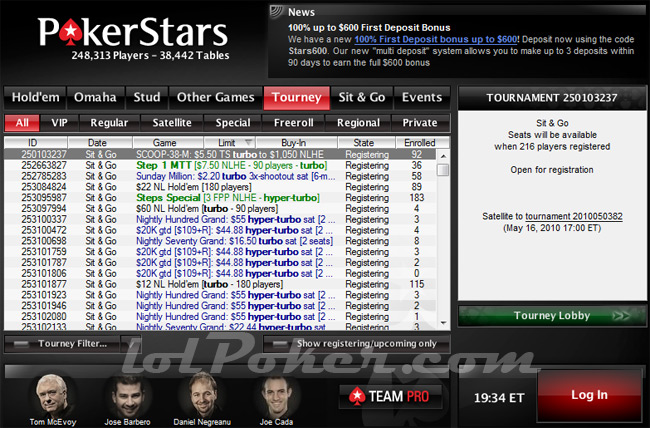Badugi Tournament Strategy
As you should know, strategy is quite different for badugi tournaments than it is for common ring and cash games. We will go through some of the most common and useful tips for tournaments which apply to multi-table tournaments and freerolls. I wrote a separate article for sit and go tourneys, which are actually small versions of regular tournaments, but they have a similar strategy involved. Tournaments themselves usually have thousands of players involved and a very generous pot that gets divided into prizes for runner-ups and the winner. In badugi, there are fixed limit, pot limit and half-pot limit tournaments available online at PokerStars. The fees can be anywhere from $1 entry buy-in up to $5000 registration or more.
Early tournament strategy and multiple tables
Once you are seated at a tournament table, the most important strategy is to start off being tight or conservative. In fact, many players just sit out for a few rounds of the big blinds. The reason why this is smart is because there are many inexperienced players who do not know what they are doing or those who are making outrageous bets. Essentially, there are players not taking the game seriously, especially in low stakes and low limit badugi tournaments. It takes about 15 minutes to half an hour or so and a huge majority of them will drop out like flies. So my advice is not so much to just totally sit out and not play poker, but wait for a very powerful hand before bringing out the big money against these hyper loose and aggressive players.
Loosen up more as time goes on and when you get used to players. You will notice at the beginning that many people will lose very quickly, but then things start slowing down a bit. At this time, card holders should start calling more often with 3 card hands and do a little bit of bluffing. When you are playing tight, you should be focusing on getting only 4 card hands. The reason is because in tournaments, a table is almost always going to be full, which reduces the chances that you will win the hand and that someone else will have a better hand. If you are playing against tight players who will only call when they get a badugi hand, then do some straight out bluffing or the strategy known as "snowing" where you stand pat and do not draw any cards in order to scare off these competitors. This works great for stealing the blinds.
Strategy to get into the money and make it to the "bubble"
The objective of a badugi tournament or any poker tournament for that matter, is to get to the bubble. A tournament will pay out prizes to not only the winner, but a number of different place holders. For instance, in a 1000 player tourney, the top 100 places might be paid some cash. This top 100 rankings is known as the bubble or where those "make it into the money". Usually the higher up you go on the ladder, the larger your prize and payouts will be. The minimum prize will cover your buy-in costs, plus a small profit, so the strategy here is to at least get into the bubble.
In badugi, you will notice that the game slows down dramatically right before the bubble since no one wants to lose right outside of the money. You will also be playing against many good and experienced players. At this point of the tournament, your poker strategy should be to play extremely tight until you ensure yourself some money. So do not go all out with anything weaker than a 4 card badugi with 8 high. Also take a few notes on what each player is doing. If there is a tight player who suddenly starts betting after a particular draw, you should immediately fold unless you have a powerful hand.
Again, if the table is full of very tight opponents, bluff them from the beginning to steal the blinds since they are likely to fold rather than risk losing at this point of the game. Everyone is basically just trying to hang on and survive until they reach the bubble. Some competition will even fold on a decent badugi hand in order to not risk losing their game, especially if they are short-stacked in chips. If you only have enough chips for one or two more blinds, wait until you immediately get any strength badugi on the starting hand and then go all-in.
If you have a large chip stack and you are confident that you will make it into the bubble, you should be loose and aggressive. That means a lot of bluffing against the tight competitors or the ones with low chip counts since they will fold like paper during this critical time of the game. Take advantage of your lead in the chips to build up more strength to last even deeper into the tournament.
How to win later in the tournament
When all of the remaining competitors make it to the bubble, the pressure instantly drops since everyone knows they will be walking away with profit. Immediately, you will see a small group of those who were hanging by a thread suddenly go "all-in" when they get a half-way decent hand as a desperate attempt to catch up again. This is actually a good strategy if you are almost out of the tournament anyways. If you are in this situation, wait until you have any kind of badugi hand or a decent 3 card hand. Ideally, you would wait until any strength 4 card badugi appears and attack the heck out of it in a last ditch effort to get back into the game.
After a bunch of people suddenly drop out, the tournament starts slowing down and becomes tighter as the final poker table approaches. Now the goal is to get to the final table and win the entire badugi tournament. Just keep doing what you were doing right before the bubble and imagine that the final table is where you want to be. Although, you do not have to be as tight since you have nothing to lose at this point and you win more money for outlasting more players.
The final table strategy gets interesting. You want to stay conservative until other people start dropping out. Less people on the table means better chances of you winning individual hands. For example, if half the table is gone and there are only 4 people left, you can certainly loosen up more since the chances of the other players having powerful hands will be much less. This is why you will see professionals being very loose at the final table. Although, it is bad strategy if you become very loose on a full table.
If you have tight players, keep being aggressive with them and fold immediately when they start calling too often. In badugi, you should definitely watch out if a tight player suddenly stops drawing more cards during the draw rounds and just decides to passively call or check their cards. The reason you should be cautious is these are typically dangerous and experienced players who are slow-playing their cards. It is much easier to spot these passive slow-playing people by watching how many cards they draw and if they suddenly stand pat but do not become aggressive.
You should use this strategy during heads up situations as well. Remember, you do not want to be too tight when the table goes heads up or when there is less competition because you have to pay the blinds much quicker and the blind limits and stakes are much higher later in the tournament. Too many times you will see the chip count of tight players dwindle away quickly into nothing because they are too afraid to call the constant bluffing or to be loose so keep this in mind and use this against your opponents as well.


 US Players and Credit Card, BitCoin Deposits Accepted!
US Players and Credit Card, BitCoin Deposits Accepted!


